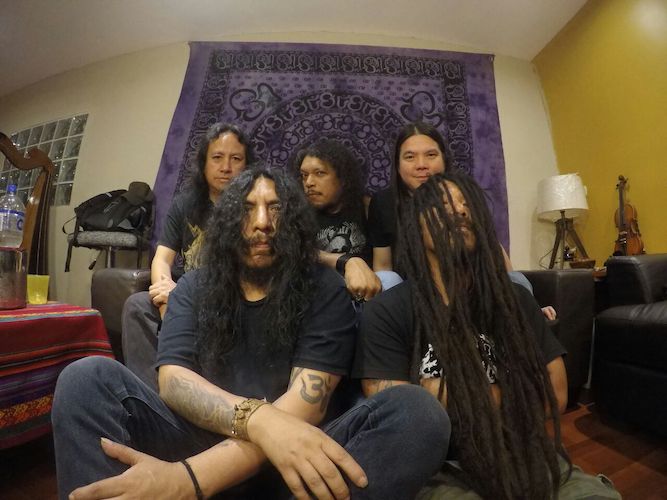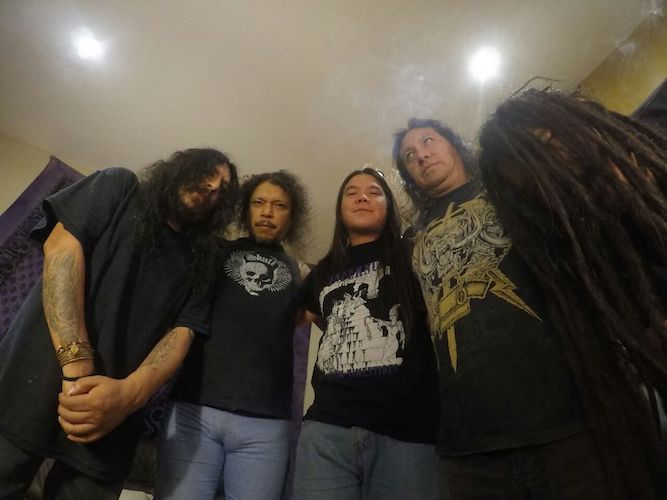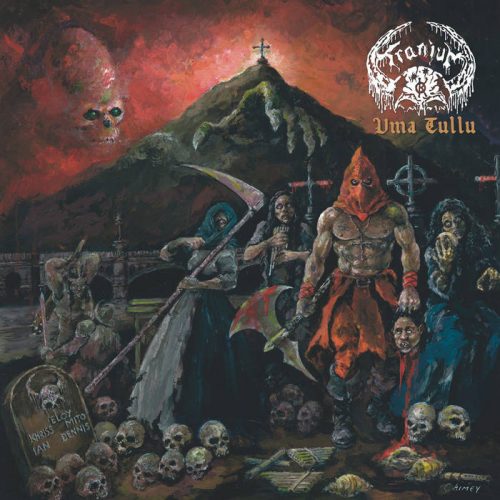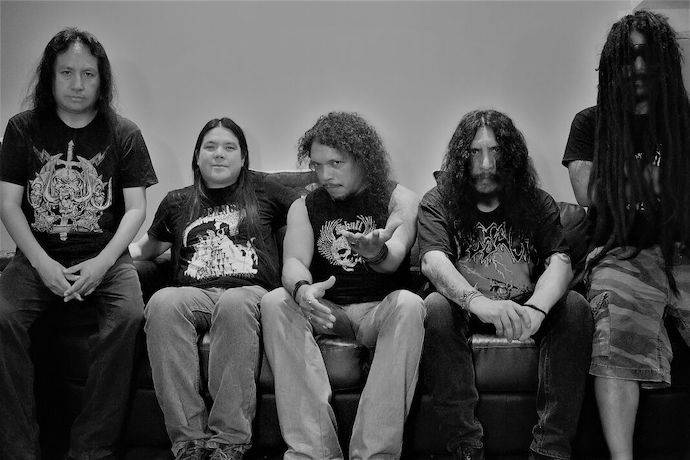
(This time Comrade Aleks interviews one of the members of the unorthodox Peruvian metal band Kranium, whose roots go back to the early ’90s and whose new album Uma Tullu (which you can stream below) was released on December 1st, 2020.)
Kranium is a legend of the Peruvian underground. The band was formed in 1985 as Murder but since 1986 it’s been known as Kranium. Their early material tended towards savage a thrash/death meta, but years passed, some members left and others joined the band, and their first full-length Testimonios finally was released in 1999. The story behind its making is long and far from easy, as Kranium drew the attention of the Swedish label Plasmatica Records who promised to fund their recording sessions but had a hard time, and lack of money prolonged recordings for almost three years.
This material appears to be a mix between traditional doom metal with a bit of a raw edge, lyrics in Spanish, and arrangements of traditional Peruvian instruments. I’m surprised that this album is a kind of “lost gem”, forgive me this cliché, and I hope Kranium’s new and authentic-as-always album Uma Tullu (released in December 2020) will reach more listeners all over the world.
The band’s lineup has changed, yet its core remains the same: Eloy Arturo (guitars, songwriting) is one of the founding members, and Mito Espíritu (guitars, wind instruments, charango) has been in the band since 1991 (there was a break for a few years, but it doesn’t make a difference). Dennis Yamazato (drums) has played in Kranium since 2005, and Ian Chang (bass) since 2010. Our current guest Christian Meléndez (vocals, keyboards) is a relatively new member — his experience in Kranium is “just” ten years. But he’s quiet a talkative collocutor, and I’m glad we had this interview.
******
Hi Christian! How are you? What’s the situation with the covid quarantine in Lima nowadays?
Hi Alexey, I’m fine and I’m glad to “talk” with you. To answer your question, well the situation here is very difficult because in the last four years we have had four different presidents, and many of them have had many problems. I’m talking about corruption in our government, institutions, and issues with our police. It is a chaotic situation and we spent the last two weeks of the year with a lot of regulations. The only way is to keep your distance with other persons and wear a mask.
How did you get into Kranium’s folk doom camp?
Yeah this is true — the band always continues to compose new music and we’ve never forgetten our past death/thrash metal, and maybe the next album will include some extreme material and traditional Kranium tunes. I love the different styles inside heavy metal, thrash, death, black, doom, hard rock, psychedelia, blues, the ’60s and ’70s. so for me it was so easy to join in the band.

What’s the whole situation with the underground metal scene nowadays in Peru?
The underground scene here is growing every year but some bands try to play through new platforms for streaming, like “virtual concerts”,. There are a few virtual concerts but we are a live band, and we didn’t play for virtual concerts, we will not, we love to play live with the real public. We have mystical and ancestral instruments, we want to share our music with the audience and play in every place, in every concert, no matter how far away your town, city, or country.
Does one of the band’s oldest members, Mito Espíritu, play all the traditional instruments during live performances? How did you solve this question?
Well, he plays most of the electric guitar and charango, and in the case of the zampoña and Quena we have some guests for performing live. Our friend/brother Guzael is a master in both instruments. We want to play more songs from our repertory but some of them are more difficult to play live because we would have to call extra musicians. Right now we are five, with our friend/brother Guzael, and six or more people on the stage is very complex.
Despite all these issues Kranium has a new full-length album Uma Tullu which saw the light of day through your own label Gestores on December 7th. How long did you compose these songs?
The songs have been composed by Eloy Arturo for all these years. He created all the songs in the band, and after that Eloy and I have made most of the musical arrangements and lyrics, with each member of the band adding some ideas for the arrangements. These songs were created many years ago, almost 15 years, and most of them have suffered some changes through the years in lyrics and arrangements.
Kranium – Uma Tullu teaser
What was on your mind when you were writing the first tracks? How did you see the core of the new material?
In our new disc, Uma Tullu, the idea was to talk about our history in Perú. For example La Tapada was a woman who used cloth over her head and only showed an eye. Some people said it was for lust or for coquetry, but we needed to make changes to the original story. We added an idea about sacrifice for eternal youth — the idea was to create a terror story with La Tapada, and most of the songs on the album have the same treatment. All themes on this album are about Peruvian history, myths, and historical events.
I remember a long story that Daniel Roncagliolo, ex-vocalist of Kranium, told about the painful recording of the band’s first album Testimonis. What are your memories of Uma Tullu recording? How much time did it take?
It is a good question because I was not yet in the band at that time, but I tell you something, in those years to make a professional recording was so difficult in our country. Eloy told me about the session of Testimonios: someone stole the tape, the band had to pay more money again and started the recording session one more time. It is usual to pass many incredible stories in the middle of the recording of Uma Tullu — we had a lot of problems there too, but this is another story, ha ha ha ha.

I believe we have enough time and space to discuss this. What kind of problems did you have with the new album?
We started creating some Uma tullu demos in January 2009 in my home studio. The same day we couldn’t continue with them because outside my house we heard a lot of noise — car horns, people screaming, crying. We tried to figure out what was going on, so I opened my door and three houses away from mine the house was in flames. On the other hand, many members in the band also had some parents and near friends pass away. In my case my girlfriend died and I was so depressed for a few years that I tried to quit Kranium. But they gave me some space and time to overcome my personal troubles. There are more histories about the recording. One day I felt too tired to continue with the recording, so I lay down on the sofa and suddenly the computer’s monitor exploded! I’m talking about an old pcs monitor type CRT… incredible things happened during the recording.
How easy is it nowadays to find a good studio with staff who know how to work with metal bands? Is it expensive?
Since 2004 it has been easier to find studios recording everywhere; in our case I have my own studio. We use Pro Tools and many old things to create our music. We love using real drums because nowadays a lot of bands use samplers or triggers and we thought, that’s a plastic drum sound. You will always find our sound natural, and real sounds except for the keyboard (I use a Yamaha keyboard and Korg Ms20 is like a Mini Moog), for guitar preamp with tubes and old stuff like compressor, aural exciter, EQs .
Kranium – Testimonis
Christian, you joined Kranium in 2013, and previously you played in Ritual and La Bruja. How has this experience helped you in Kranium?
I played guitar and bass in different underground bands since 1996, and most of them were death metal or death doom. I love this kind of style but I was looking for a band, not a bunch of guys playing just to spend some time. I tried to bring many ideas for making a demo or discs with theses bands, but I couldn’t do it. For me it was an experience in rehearsals, and concerts. I learned a lot of things with different bands. I shared my ’70s classic rock taste with Eloy from La Bruja band; it is a power trio with ’70s influences. I played, recorded, and mixed the new album.
How much of your own contribution is in Uma Tullu?
In all the songs I made some arrangements. We shared many ideas together with Eloy, and the band knows what kind of sound I like. For example the Leslie Hammond effect in many songs, or my classical sound, the choir sound, and melodic and obscure melodies like in ‘Catacumbas’.
Before Uma Tullu was released, the band didn’t release any new songs for ages! How did Kranium spend this period since your joining Kranium?
The band had many changes in their line-up in those years, and these kinds of things contributed to a long silence. The band had some demos and songs recorded, but never published. I think these songs aren’t great enough for today, and time helped us to choose the best songs from this period and create new songs for Uma Tullu and make a new arrangement for the old songs
Kranium is quite an authentic band, whose sound consists of a few original elements. How would you sumamarize the main features of the new songs?
I had been thinking about the question because the band is a mix of metal, the ’60s and ’70s classic rock, and traditional music from Peru. Actually there are three regions in Peru: the coast, the highlands, and the jungle. And theses three regions have different artistic expressions: dance, musical styles like vals, festejo, huayno, sikuri, pandilla. And we tried to use our regional musical variety plus metal (especially Black Sabbath) and mix it up with ’60s and ’70s flavor, and that is Kranium.

In which region were you born? How did this fact influence your musical interests?
I was born on the coast, and my parents too. I live near the beach (25 minutes approximately). I live in a beautiful and quiet neighborhood, but when I was a child I lived in a poor, violent neighborhood. All the bad things you could think of, you found it here — drug dealers, fights, robbers, kidnappers.
In this neighborhood I learned to hear different musical styles because on the second floor of the building where I lived you could hear Latin romantic music like Julio Iglesias, Roberto Carlos, Raphael, and beside my house – rock/pop radio music like Pat Benatar, Cyndi Lauper, Van Halen, REO Speedwagon. And in my house was always traditional Peruvian music, like Valses, Polkas, festejo, salsa and also rock/pop for my siblings, music like Phil Collins, Kenny logins, Madonna, Twisted Sister, Quiet Riot. And on the other side of my house you could find an alley with many people there, poor people with a heart of gold, and they listened to traditional Peruvian music from the highlands, Huayno, pandilla, Yaravi, also chicha and cumbia, and I think this variety give me a strange musical taste.
I’ve listened to heavy metal since I was 9 years old. It was difficult to find metal music here in those days (the ’80s). I used to buy copies of tape’ in a place called “Colmena” in the ’80s. It was a perfect place for buying metal tapes and vinyl. It was an avenue with many vendors on the street showing copies of tapes because it was expensive to get an original tape, and hard to find too. I saved all my money (a kid, 9 or 10 years old, hahaha ) and tried to choose the best tape music. Nowadays I still have two-hundred tapes from those days because the most important thing for me is never to forgot where you come from. Every time I see those tapes I remember walking for 30 minutes to buy a tape and continue to walk back home thirsty, tired, with no money, but happy to have another tape in my hands.
It reminds me a bit of Russia in the ’90s…. But well… considering Kranium… Uma Tullu has such an epic booklet, and it’s totally in Spanish! Didn’t you even aim to reach foreign ears with a new release? How do you promote the album nowadays?
Great question!!! I thought about singing the album in Spanish, Quechua, and English to reach more audiences, but phonetically that changes everything. The idea is surrounding us. We have some social networks — Facebook, Instagram, Bandcamp, YouTube — and we try to promote our material this way (we are very caveman in this type of thing).
Kranium
Have you managed to play some of these songs live?
We had been playing two songs at the last concerts — for some of them it was ‘La viuda negra’ and ‘El Vago del cementerio’, and sometimes we switched with ‘Catacumbas’ or ‘Santa Inquisicion’, though both songs are too long for a concert (more than 15 minutes in length). Our performance in concert is for 45 minutes or for an hour because we share the concert with other bands.
As I understand Uma Tullu the story is built around the Europeans’ invasion of South America. Can you tell more about the lyrics?
No, it is not about European invasions but is about our history many years after the Inca Empire. We were conquered by the Spanish and they brought many new things, like their religion and behaviors. This kind of thing we talk about in the first song, ‘Santa Inquisicion’. ‘Presbitero maestro’ is about the first cemetery in our city Lima, and somebody finding many souls and talking with them.Most of the album is about stories, myth, legends, and true historical facts in our old city.
The Inquisition is a popular theme in doom metal, and forgive me my ignorance, but I never heard about any inquisition in South America – mostly about genocides, which occurred on a regular basis back then. What was the role of the church and inquisitions particularly, in this?
After the conquest by the Spanish our land suffered many changes, and there arrived la Santa Inquisicion trying to copy a similar pattern in Spain and France. They imposed this religión and they took control of our penances system, and chose different types of punishment. But it was mandatory nobody could bleed. They tried the suspect to confess, but before people were tortured, scourged, exiled, and killed. The role of the church was in charge of overseeing the strict compliance with the Catholic faith in the Inquisition, called The Tribunal of the Holy Office, which was like a judge and jury all in one.
The question is blunt, but what are your plans concerning Kranium in 2021?
We have started to make some demos for the next album, sharing ideas for the songs in a virtual way, and tried to play some gigs, but the coronavirus is a global problem and we haven’t been playing since February 2020. We need to wait more time for the vaccine (which I hope will work).
Christian, I believe it’s a good point to finish this interview! I hope we’ll have new cause for another interview soon. Thanks for your time, it’s good that we’re able to spread such news even now despite this situation in the world.
https://kranium.bandcamp.com/album/uma-tullu-2
https://www.facebook.com/KRANIUM-PERU-321159148025438/
